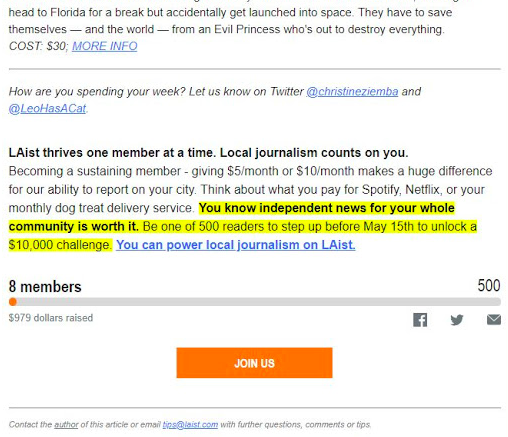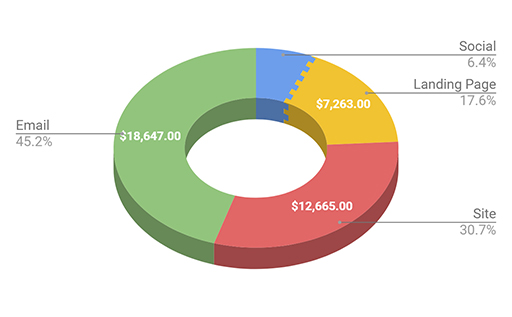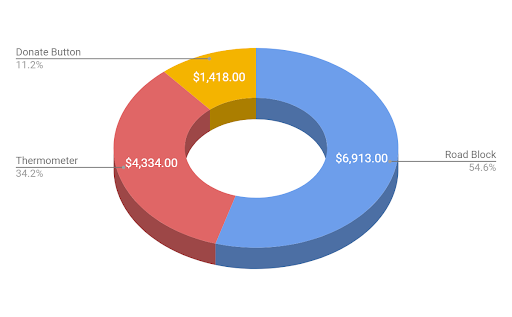How KPCC and LAist adapted the public radio fundraising strategy for a digitally native audience
Danny Sway, KPCC - Southern California Public Radio,This is a series on Better News to a) showcase innovative/experimental ideas that emerge from the Knight-Lenfest Newsroom Initiative and b) to share replicable tactics that benefit the news industry as a whole. This “win” comes from Danny Sway, digital fundraising manager for KPCC and LAist. KPCC participated in Poynter Institute’s Local News Innovation Program in 2018-19.
API and Poynter teamed up to take a deeper look at KPCC and LAist’s experience with transforming themselves. Here, you can read about how the news organizations experimented with a new fundraising strategy for digital audiences, and over at Poynter, you can learn how LAist took the public media model of member swag and tweaked it for digital audiences.
Question: What problem were you trying to solve, and why was solving the problem strategically important for your organization?
Answer: Our public radio newsroom, KPCC, purchased and revived LAist, a digital journalism destination, one year ago. The site had been abruptly shut down by its billionaire owner in 2017. With its revival came about 30,000 newsletter subscribers, a solid social media following and a vocal group of readers who missed the site and the local journalism it provided.
We reinstated LAist with a non-profit, member-supported funding model, which was a departure from the ad-serving revenue model that the LAist audience was accustomed to.
We needed to educate this audience about our non-profit model and a new value proposition: LAist could only thrive with their support as donating members. And then, once we established that, there were some big open questions:
- How do we get them to join team LAist by donating during a fundraising campaign?
- How can we adopt the tried-and-true on-air public radio pledge drive for a digitally native audience that doesn’t listen to pledge drive pitch breaks? How do we get them to act without a paywall or too many annoying messages on the site?
We needed to get a convincing “ask message” in front of readers, one that would get them to step up their engagement to the next level: donating.
We had reason to be hopeful. The membership model is KPCC’s largest source of funding. That’s how we engage with our most passionate listeners. Surely it should work for our most passionate LAist readers, right?
Membership models come second nature to us in public radio — it’s our main way of activating the community. When they give, they’re connecting with our journalism, and they feel empowered by their donation. Membership models are becoming more mainstream for all kinds of different organizations. But public radio wrote the book on membership, and it fits the work of LAist well. So why not try it?
Q: How is this approach related to Table Stakes (e.g. one of the 7 Table Stakes and/or an outgrowth of the Knight-Lenfest initiative, etc.)?
A: Our goal is related to Table Stake No. 4: Funnel occasional users to habitual and paying loyalists. It’s more art than science: Knowing when and where your audience is ready to be asked to deepen their engagement with a fundraising solicitation.
Q: How did you go about solving the problem?
A: We wanted to adopt on-air pledge drive strategies but we didn’t have a captive on-air audience like we do with our radio fundraising (and even then, we know people can flip the dial).
We needed a fundraising approach that wouldn’t be easily ignored. We knew that we would never have a paywall. We’re public media, and we’ve built our KPCC membership around making a case to people: Even though our content is free, it’s worth paying for.
To help our fundraising team succeed, we empowered them to work closely with the content team to serve our audience better and create better “ask” messages that accomplished the goals of our newsroom:
- We served our newsletter audience with targeted asks that reflected the core values of the organization and reflected what readers value.
- We built a social media calendar to track when and how we were communicating with our audience, adapting messages to fit different channels: Facebook, Twitter, Instagram, and Instagram Stories.
- We built connections across the organization between fundraisers and content editors to craft messages that felt honest and got to the core of why we needed audience support.
We decided that the site itself needed to be interrupted in some way, to make sure readers couldn’t miss this fund drive. We created digital technologies that temporarily interrupted (but didn’t block) the content LAist readers wanted to get to.
We also wanted to create technologies that mirrored a Kickstarter-esque experience since we knew that was familiar to this audience. To that end, we wanted readers to be able to keep track easily of the fundraising challenge and to see us reach our goal. And we wanted to create a landing page where we could educate social and new audiences about the site’s new non-profit model, in case readers still needed to be convinced of our mission and value.
It was important to shape the campaign around a specific goal. As we learned from our Kickstarter campaign to Bring LAist Back, this was a tangible goal that one person donating could have a visible impact on. So we set our member goal at 500 donors and designed a “thermometer-style” gauge that would help people track the campaign’s progress.
We assembled a small core team of fundraisers, digital product specialists and web developers who made a wish-list of digital tools and strategies and honed that list into a few action items. We ended up designing:
- An unobtrusive digital roadblock that popped up in the bottom third of the screen and followed the reader around on the page as they scrolled
- A campaign thermometer to track the number of donations coming in
- A landing page that featured testimonials, the impact of our work, and compelling descriptions of why we needed reader support
To create fundraising functionality on the site, we worked with our web developers to build anchored footers that traveled with readers as they scrolled the page, as well as a donation button on the homepage and after-article asks that featured the campaign thermometer and custom “ask” messages.

In this screen shot, you can see an example of an after-article ask that included our campaign thermometer.
The digital products team developed these core technologies. The fundraising team built a framework for how the campaign would run. The content team helped craft messages that spoke to the reader one-on-one, talking about our work from the perspective of our editors.
We worked with the content team to build a catch-all landing page that explained our non-profit, member-supported business model. Our goal was to show engaged readers that our value proposition was that our journalism is free for all to enjoy, but relies on their generous support to exist.
We also worked with the content team to build fundraising emails that were penned by LAist content editors, each with their unique voices and perspectives to explain why what they do matters and what sets us apart from other news organizations out there.
That was crucial because email was the platform of choice to make a compelling ask similar to our on-air pitch breaks. That’s where our reporters talk about the cost of their reporting, the impact of their work and why it’s important to support them.
We had only one month to plan this fundraiser. But in that month, we made great progress learning how to use each department’s expertise and skills wisely to reach our goal. Although it wasn’t the first time different departments in our organization worked together, this specific campaign helped us share knowledge across departments, from fundraising best practices to editing processes.
Q: What worked?
A: Creating a landing page that explains our nonprofit model turned out to be the right move. We drove our social media audiences there and saw a large number of donations both directly through social and then from the landing page itself. Driving KPCC’s social audiences to donate has typically been difficult.

A breakdown of donations from referral sources. Social posts often linked to the landing page, so the line is blurred there.
We deployed a variety of email fundraising strategies, which was a learning experience to see what connected with our newsletter audience. A few emails used known fundraising strategies, including a dollar-for-dollar match day, a discount thank-you gift day and a message that explained the overarching challenge of the fundraiser: We need 500 donors to unlock an additional $10,000 for local journalism.
Working with the content team, we talked about our organization’s mission and the specific beats we cover, like arts and food. One editor described how our journalists were fearless and how she was afraid of them. That performed well with our audience!
Our goal was to establish that one-on-one connection between our journalists and readers (and listeners), explaining why our journalism matters and what it takes to make our work a reality. We already do this well during on-air pledge drives.
| Email content | Number of donations | Amount attributed to email | |
| Email 1 | Campaign intro, education, by editor Melissa | 43 | $3,478 |
| Email 2 | Details of the $10k challenge, by fundraiser Rob | 25 | $2,239 |
| Email 3 | Top stories, mission statement, by editor Megan | 14 | $848 |
| Email 4 | Discusses mission and reporters, by editor Lisa | 33 | $2,451 |
| Email 5 | Food coverage, weekend send, by food editor Elina | 3 | $160 |
| Email 6 | Dollar for dollar match challenge, by fundraiser Deanna | 29 | $1,341 |
| Email 7 | $5 Friday, transactional / merch, by fundraiser Danny | 33 | $2,249 |
| Email 8 | Arts and entertainment, by entertainment editor Mike | 12 | $573 |
| Email 9 | Challenge update, made goal, by fundraiser Rob | 16 | $1,058 |
| Email 10 | End of campaign, dollar for dollar match, by editor Melissa | 23 | $1,377 |
The site tools we developed worked. Here’s a breakdown of donations that came in from all site tools. We were pleased to see that the road block received the majority of our site donations (which were separate from the email campaign donations).

Donations from the site tools represented about 30 percent of the total we received during this campaign.
Beyond using social media as a way to fundraise, we saw it as an ideal place to update our audiences during the campaign about our progress and their role in our success.
At the end of the campaign, we surpassed our goal of 500 members and received 585 donations. Since this was the first fundraising campaign for LAist, we set a modest dollar goal of $25,000 but ended up raising $40,949 with an average gift of $70. Of all donors during this campaign, 70% were uniquely LAist donors, with only 30% being previous KPCC donors.

We used Instagram Stories to tell our audiences how our campaign was doing and to thank them for their donations.
Another goal, which is harder to measure, was education: starting to inform the LAist audience of our new non-profit member-supported model. LAist used to be for-profit and ad-served, so we designed the informational landing page and strong non-profit fundraising language throughout the campaign. The education of our audience on our non-profit model is still a work in progress, but this campaign was a good leap forward.
Q: What didn’t work?
A: Some of our strategies for emails landed a bit flat. We tried to email on the weekend, which had a 16.8% open rate and only three donations. Some emails didn’t perform as well as we would have liked. The email from our editor Megan Garvey was written strongly and had convincing descriptions of our mission statement. But it underperformed because we linked directly to stories that had an impact. That distracted readers from focusing on the core point of the email, which was to go to the donation page.
Q: What happened that you didn’t expect?
A: We experienced many happy surprises with this campaign, including:
- A higher average gift than we expected
- Lots of monthly donations (what we in public radio call “sustainers”)
- Of those sustainers, 41% of them chose to send their gift directly from their bank account, which means a higher level of trust (and a lower chance of donors falling off due to payment method changes)
Q: What would you do differently now? What did you learn?
A: The landing page was an intermediate step between an ask on social and a donate page. But we only had one landing page, so we couldn’t tell where donors originated.
Next time, we will clone the landing page and make unique donation links so that we can track donations and traffic from each referral source (Twitter, other social channels, the thermometer button, etc.).
Also, next time, we will talk more broadly about our mission and our promise to the reader. We unveiled our organization’s mission statement and individual reporter’s mission statements right after this campaign, tied to our more traditional on-air campaign.
Q: What advice would you give to others who try to do this?
A: If you try this approach for the first time, set a conservative and attainable goal. Consider the size of your digital audience, the size of your newsletter list (and if you’ve been serving them with lots of content) and your social audience’s size and level of engagement. If you already have a membership model, calculate the size of your average gift to help set your campaign goal.
When working across departments, play to everyone’s strengths. Keep all ideas (bad and good) flowing and allow the brainstorming to be collaborative and inviting. You may have expertise in your department about fundraising best practices, but other teams might have audience insights, engagement tactics and a developed voice and repartee with your audience that are key to fundraising.
Q: Anything else you want to share about this initiative?
A: The public radio audience loves great-looking merchandise! (The tote bag is iconic.) Nonprofit newsrooms have ventured into this territory but haven’t yet capitalized on their audience’s desire to wear well-designed, branded merch. It’s important to focus on fundraising, but using merchandise as a marketing approach is worthwhile, too.